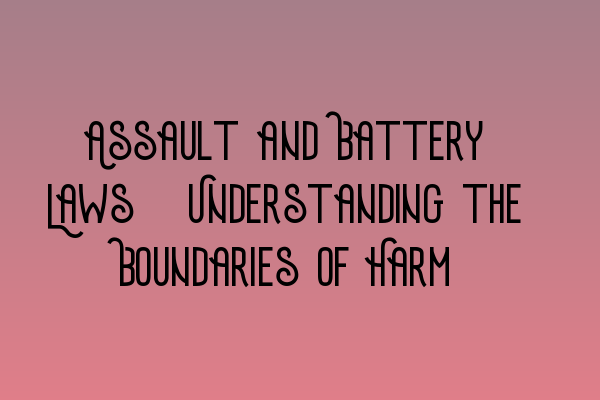Assault and Battery Laws: Understanding the Boundaries of Harm
Assault and battery are two common criminal offenses that involve intentional physical harm or the threat of harm. These offenses are categorized under criminal law and understanding their boundaries is important to accurately interpret and apply the law.
What is Assault?
Assault refers to the intentional act of causing apprehension of harmful or offensive physical contact. It doesn’t necessarily involve physical contact but focuses on the fear or anticipation of harm. The severity of assault charges can vary depending on factors such as the intent, level of threat, and the presence of a weapon.
In some cases, assault charges may result from a verbal threat combined with actions that reasonably cause fear in the victim. Remember, assault is not limited to physical attacks. It can also include actions like pointing a weapon at someone or making credible threats.
If you require further information on the specific elements required to prove assault, visit our related article on SQE 1 Practice Mocks FLK1 FLK2 that offers practice exam questions to test your understanding.
What is Battery?
Battery involves the intentional infliction of harmful or offensive physical contact on another person. Unlike assault, this offense includes actual physical contact between the perpetrator and the victim.
Battery charges can be elevated depending on the severity of the injuries inflicted or the use of weapons. It is worth noting that the absence of visible injuries does not negate a battery charge. Any intentional physical contact without consent may be considered a battery offense.
For more in-depth information and examples of battery charges, we recommend browsing through our related article on SQE 1 Practice Exam Questions that provides practice quizzes to enhance your understanding of the topic.
The Boundaries of Harm
Assault and battery laws aim to protect individuals from harm or the threat of harm. However, it is essential to understand the limits and boundaries of harm within the context of these offenses.
In some situations, the level of harm inflicted may lead to more severe charges or enhance the penalties associated with assault and battery. For instance, if the harm results in severe bodily injuries or if the assault is committed against certain protected classes such as law enforcement officers or healthcare professionals, the charges may be elevated.
It is advisable to consult our article on SQE 1 Preparation Courses to gain comprehensive knowledge about the boundaries of harm in assault and battery cases. These preparation courses offer valuable insights and resources to help you understand the intricacies of the law.
Stay Informed
As laws and regulations evolve, it is crucial to stay informed about any changes or updates in assault and battery laws. Ensuring that you are up-to-date with the latest legal developments can help you provide effective representation and guidance to clients.
To stay informed about the latest SRA SQE exam dates and other important announcements, we recommend visiting our article on SRA SQE Exam Dates. This resource provides important information about exam schedules, registration deadlines, and other relevant updates.
Conclusion
Assault and battery laws encompass various aspects of intentional physical harm or the fear of harm. Understanding the boundaries of harm is crucial for legal professionals practicing criminal law.
For further resources, including SQE 2 preparation courses and additional practice materials, consider exploring our article on SQE 2 Preparation Courses. These courses offer comprehensive study materials and mock exams to help you excel in your legal career.
Remember, constantly enhancing your knowledge and staying updated with legal developments will not only benefit your clients but also contribute to your professional growth.
